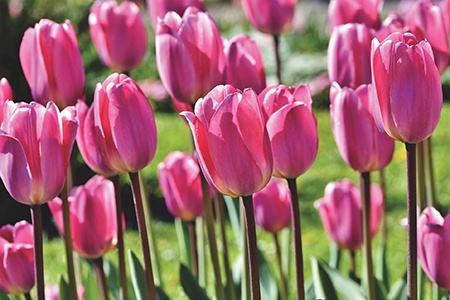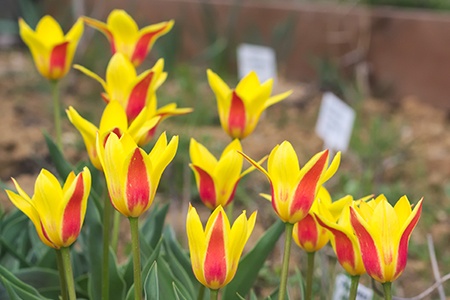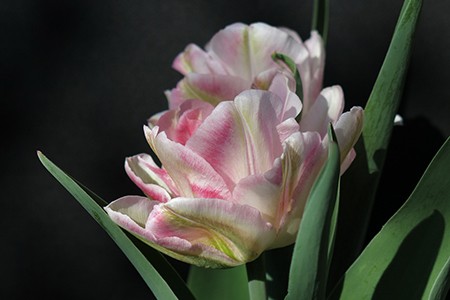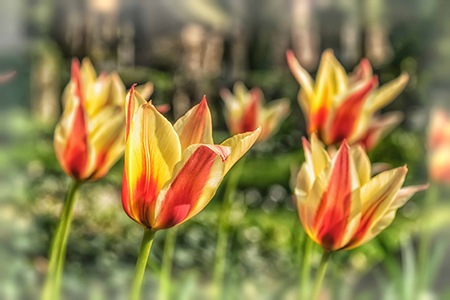15 Main Types of Tulips to Reinvigorate Your Flower Bed
Author: Jen Worst | Editor: Omar Alonso
Review & Research: Jen Worst & Chris Miller

Any of the types of tulips can enhance the beauty of a garden by their mere presence. The vibrant colors can make any garden go from mediocre to absolutely breathtaking. In the Spring season, various types of tulips stand out as one of the best flowers to plant in your garden.
But not all tulips are suitable for every garden. Before planting them, it’s essential to know all about the different types of tulips. In this article, we aim to give you all the necessary information about that.
15 Types of Tulips
In the Netherlands, just before tulip season begins, they celebrate on the 3rd Saturday every January their National Tulip Day. It's been held for 12 years now, with as many as 18,000 people coming from 100 different nations. Everybody loves tulips!
There are about 75 different species of tulips. While we may not cover all of the individual species, we will try our best to give you some details about the 15 groups they are divided into.
Single Early Tulips

As the name suggests, these bloom in early Spring. These flowers open only when the weather is cool. So, they tend to last pretty long compared to others.
They tend to have a cup-like shape with six petals, and they are pretty well known for that. The average height of the flowers is around 10-18 inches. They look great in any types of gardens you may be maintaining.
Single Late Tulips

Again, it’s obvious from the name that these bloom in late Spring. In shape, they are pretty similar to Single Early Tulips. These tulip varieties also have a cup-shaped structure with six petals.
But these varieties of tulips come in a much wider range of colors. They are also the tallest types of tulips you can find, as their average height is around 18-30 inches.
French Single Late Tulips

Even though these tulip types share many similarities with standard single late tulips, they have enough differences to warrant a separate group for the French single late tulips.
These have the same average height range, but they tend to grow much taller than the standard variety. They also last for a very long time.
A notable difference between these and the standard variety of single late tulips is in their shapes. Compared to the cup-like shape of the single late ones, these usually have an oblong shape.
Double Tulips

These have the names of Double tulips because of their semi-double or double flowers. These can be divided into two different types depending on when they bloom, i.e., Double early bloomers and Double late bloomers.
These tend to have an average stem height of around 10-16 inches. But the bloom can often grow up to 6 inches as well. They tend to last for a long time after blooming.
Darwin Hybrid Tulips

Unlike all the varieties of tulips we have covered so far, these bloom in mid-spring. They are perennial, and so they last for a very long time. These kinds of tulips are trendy among gardeners for their gorgeous colors. They can totally enhance the beauty of your garden.
Not only that, but these types of tulips are also very resistant to heavy rain and wind. So, they don’t require much maintenance. They are also perfect for forcing.
Greigii Tulips

These kinds of tulips are very well known because of their unique shape. The flowers are shaped like a chalice, and the variety of colors they come with make them very pleasant to the eyes.
They open and close after specific periods, and both the exterior and interior colors are gorgeous.
Like the Darwin Hybrids, these are also mid-season bloomers. The Greige is comparatively quite tall as well, at around 9-20 inches. If you own a rock garden, these tulips would be a natural fit.
Fosteriana Tulips

The flowers of these tulips are known to be extremely large and long. But their stems tend to be relatively short. The maximum height for the stem is 10 inches.
These kinds of tulips are very well known for all the different rich colors they come in, much like the various types of jasmine flowers. These are must-haves in rock gardens and borders.
Fosteriana tulips are good for perennializing, forcing, and naturalizing. Like the single early tulips, they bloom in early Spring.
Kaufmanniana Tulips

The best part about these types of tulips is their versatility. You can grow these in rock gardens, pots, window boxes, and many other places. And regardless of where you grow them, they never fail to look stunning with their wide range of colors.
Another plus point is that they are pretty perennial, and you don’t have to worry about their withering any time soon after blooming. They look amazing next to any of the types of hibiscus, giving off a very tropical feel.
Like the double tulips, they also have two different types based on their time of blooming. Some of these bloom in early Spring whereas, some grow in mid-spring though both have the same features.
Now, speaking of features, their average height is pretty low at around four to six inches only. Some varieties barely reach four inches. The flowers of these different kinds of tulips are usually open wide, just like lilies.
Lily-Flowered Tulips

The Kaufmanniana variety may have flowers that look like a Lily, but these almost look identical to Lilies. In fact, you wouldn’t be blamed if you mistake these for Lilies.
Just like Lilies, these flowers are known to be very elegant and gorgeous, and rightfully so. The long-pointed petals, the star-shaped blooms, the wide variety of beautiful colors all make these tulip varieties a sight to behold.
These all contribute to giving it a royal appearance that will easily enhance the beauty of your garden. You can grow these in your rock gardens.
They usually bloom in late Spring, and they are incredibly tall. The average height of the stem of these kinds of flowers is around 18 to 24 inches. However, there have been instances where they were found to be 32 inches long.
Fringed Tulips

These tulip types are very soft and delicate flowers, and they will improve the look of any garden with their mere presence. These kinds of flowers usually come in five different colors. They are red, violet, white, pink and yellow.
Some of these tulips bloom in mid-spring. But some of them take much longer to grow and bloom in late Spring. Unfortunately, they don’t last very long. That's why you've got to have your flower bed full of various types of peonies and other options so you've always got something grand to enjoy.
Triumph Tulips

Maybe these kinds of tulips are called Triumph Tulips because they triumph over all other types of tulips in sheer number alone. They are comfortably the largest group of tulips.
Not only that, but they also have the widest range of colors among all varieties of tulips. That makes them a desirable choice for your garden.
Furthermore, their adorable cup-shaped flowers contribute to their case. Everyone loves the classic cup shaped flowers, which are accentuated by all the different colors they have.
They are pretty resistant to heavy rain, wind, and cold temperatures, so they require little maintenance compared to other kinds.
These flowers are perfect for short-term bedding or forcing. They can also live for a long time in most types of vases. So, you can also use them as cut flowers if you want. Consider growing thew with any types of violets to get a similar color but a beautiful variety of shape.
Parrot Tulips

You could actually say these tulips are a different variety of fringed tulips in some ways, as they share a few similarities. Most notably, these kinds of tulips also have a lot of fringes at their edges. Alongside that, the edges are also very feathery and frilly.
These kinds of tulips are best known for their beauty. As the name suggests, these flowers come with many vibrant colors that are identical to parrots most of the time.
So far, seven different shades of colors have been identified in this variety of flowers. These are white, pink, red, purple, green, yellow, and orange.
If that wasn’t all, they also come with the classic cup shape. And as we have already discussed before, everybody loves the classic cup shape. Their exotic look would enhance the beauty of any garden considerably.
But it should be mentioned that these flowers are not very resistant to heavy rain or wind. So, you might have to take extra care to make sure the weather doesn’t affect these.
Viridiflora Tulips

The name for these types of tulips sounds very exotic, and this variety absolutely lives up to that name. This variety of tulips is very rare, and you would be fortunate to find them.
While most people don’t grow them in their gardens, connoisseurs tend to have a deep appreciation for the flower’s beauty, and understandably so.
The name Viridiflora literally translates to “Green Flower.” It’s called that because all flowers that fall under this variety have a green streak to them. Besides that, the green is usually complemented by a second color, but that color differs from flower to flower.
These flowers are late bloomers. They have an average height of around 16-24 inches. So, they are pretty tall compared to other types of flowers.
Species Tulips

These tulips can be compared to underdogs. Despite being one of the smallest varieties of tulips, they are the most long-lasting.
The average height of these tulips is around 3-8 inches, which is relatively short compared to most tulips. But they live longer than any other variety in existence. These tulips are perfect for rock gardens or borders.
Rembrandt Tulips

These tulips are named after the Dutch painter Rembrandt. These, apparently, originated after the spread of a virus.
These different kinds of tulips can vary significantly in bloom times, shapes, and height depending on the specific origins of the flower.
Types of Tulips for Every Flower Bed
Before doing anything, it’s imperative to have proper knowledge of the thing that you’re doing. The same goes for planting tulips.
Hopefully, this article could give you a general idea about the diverse world of tulips. With some more research, you will be ready to find the right tulips for your garden, and your garden will awe everyone with its beauty.
If you don't know about the different types of tulips, how each can complement your garden, and how you should go about growing them, you’re bound to make mistakes. But now you know!



